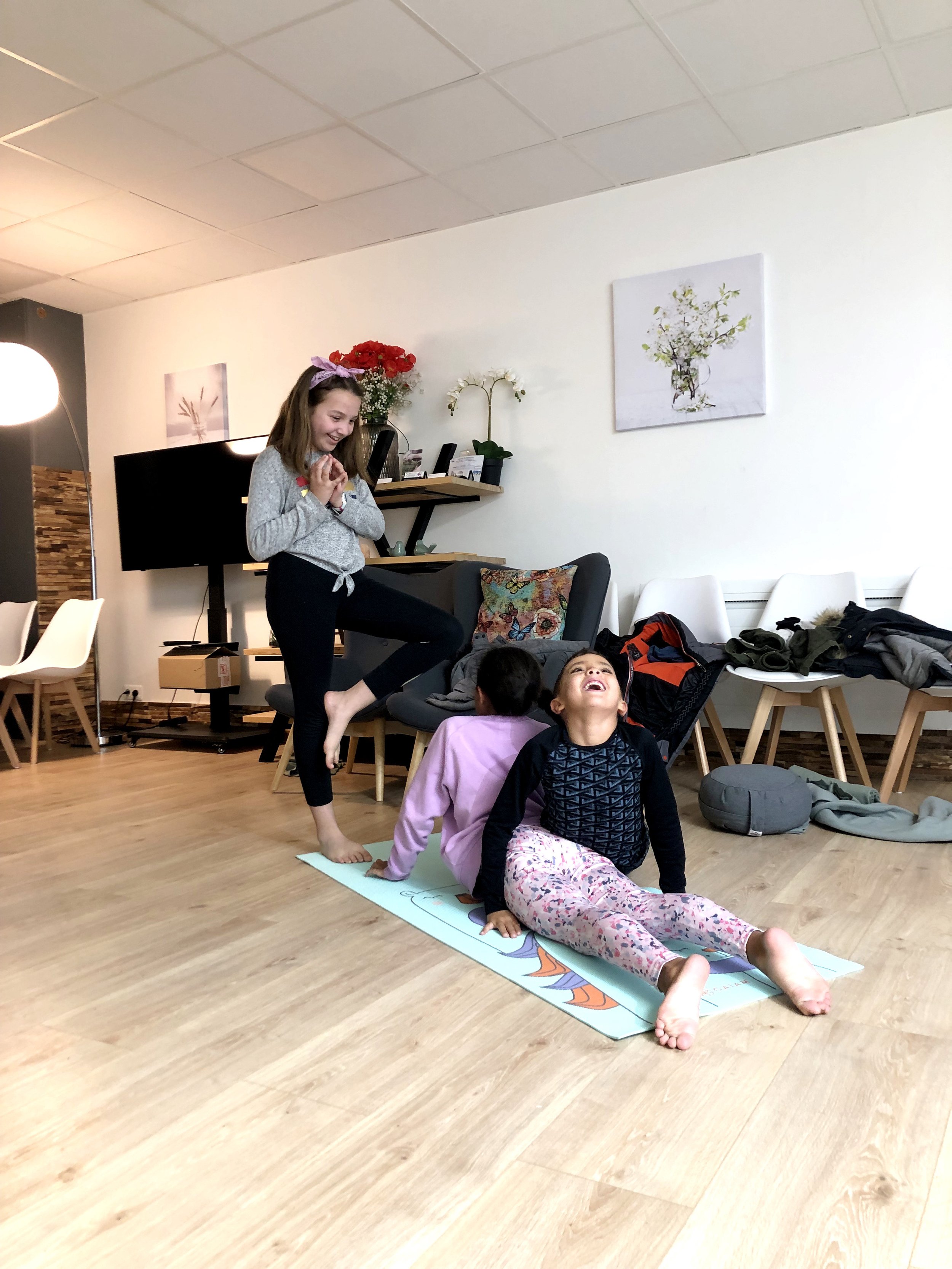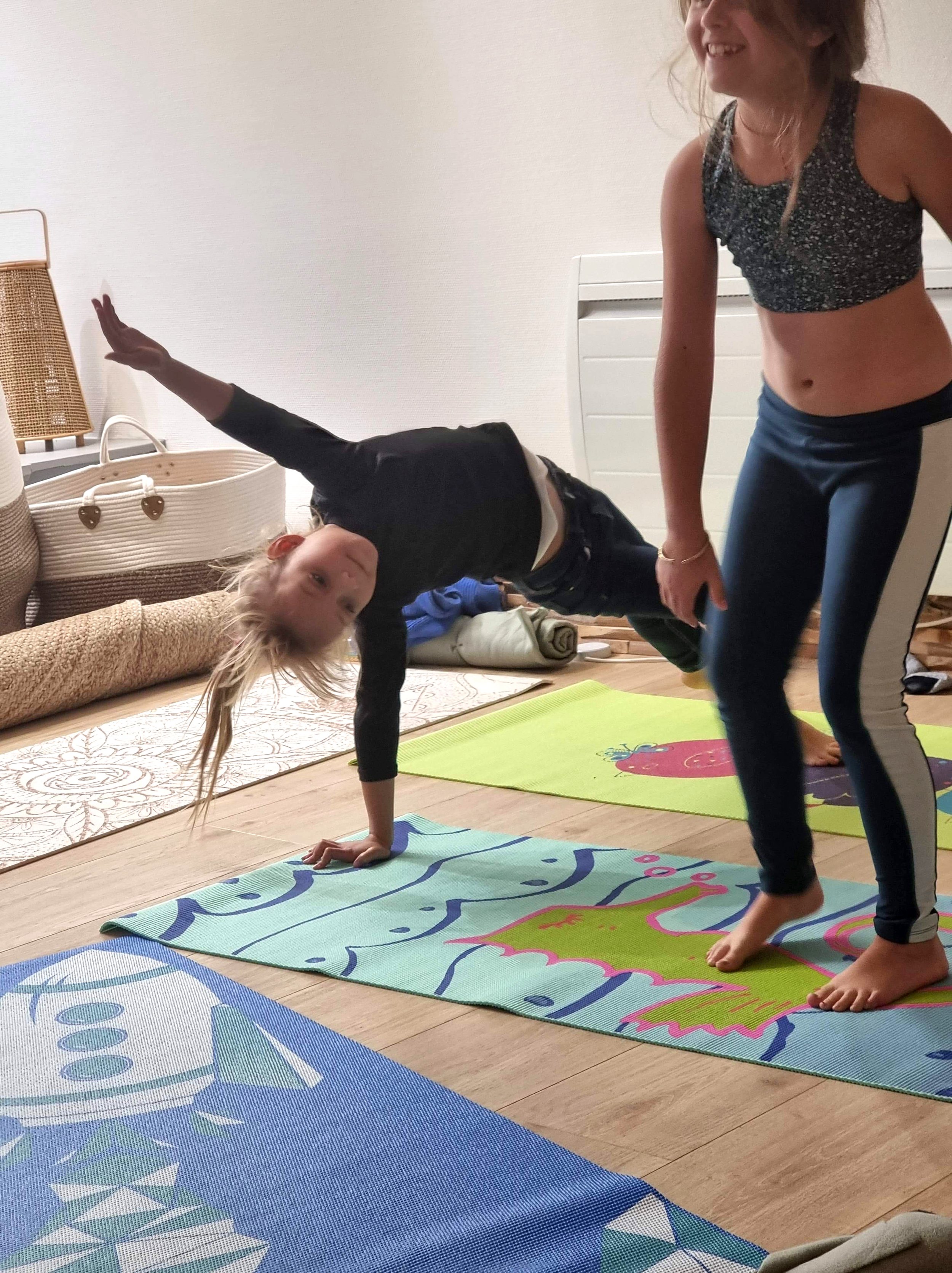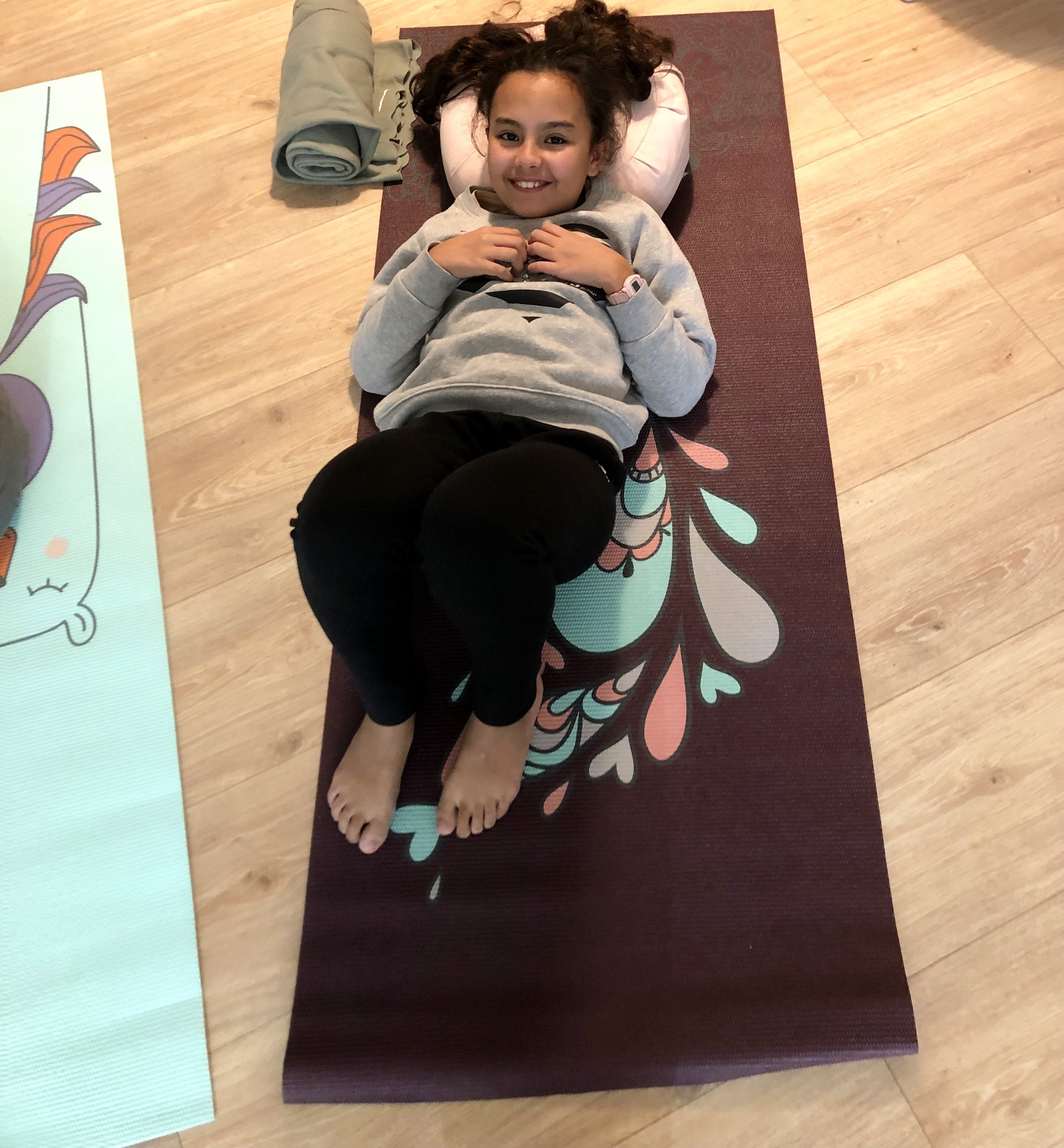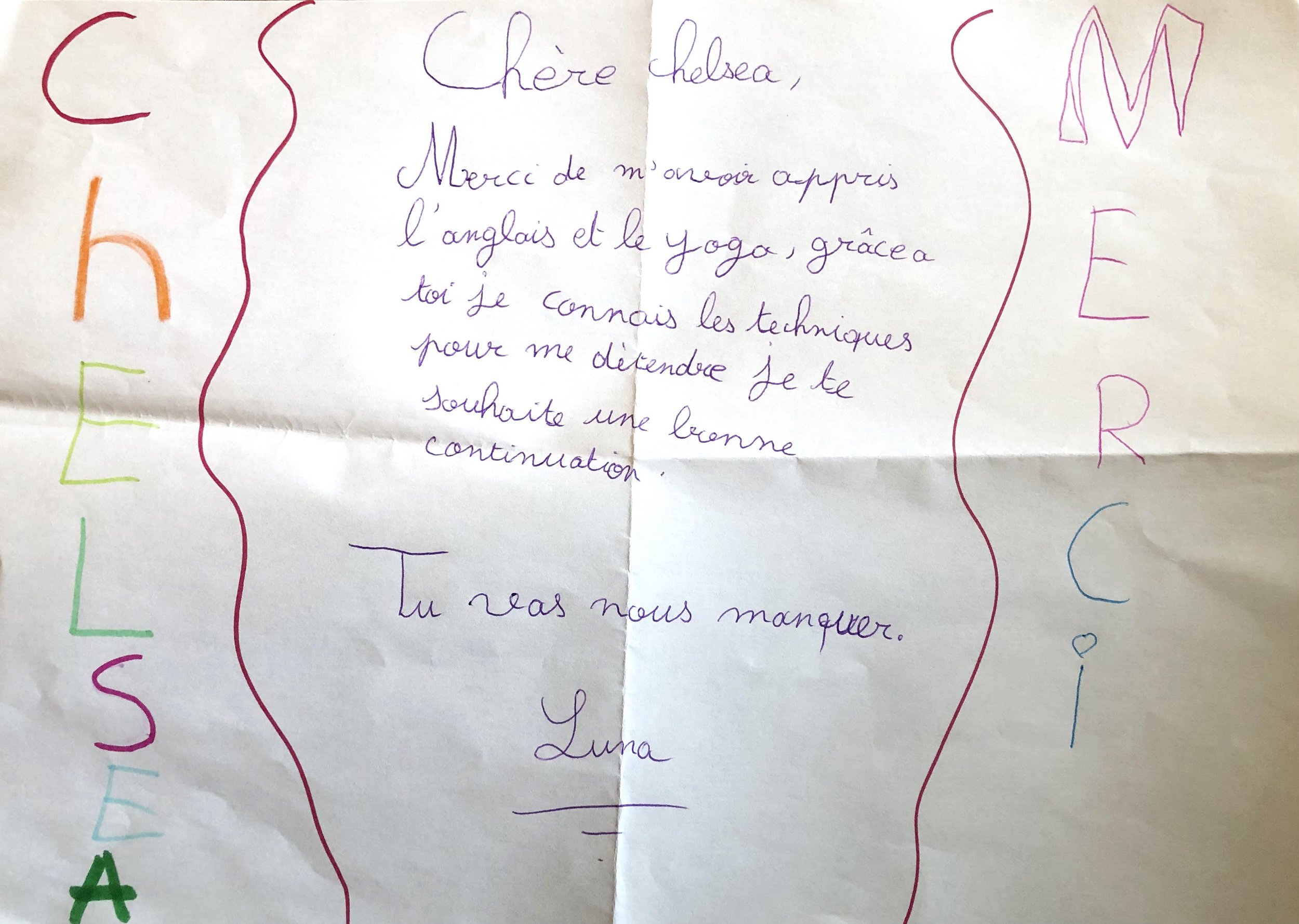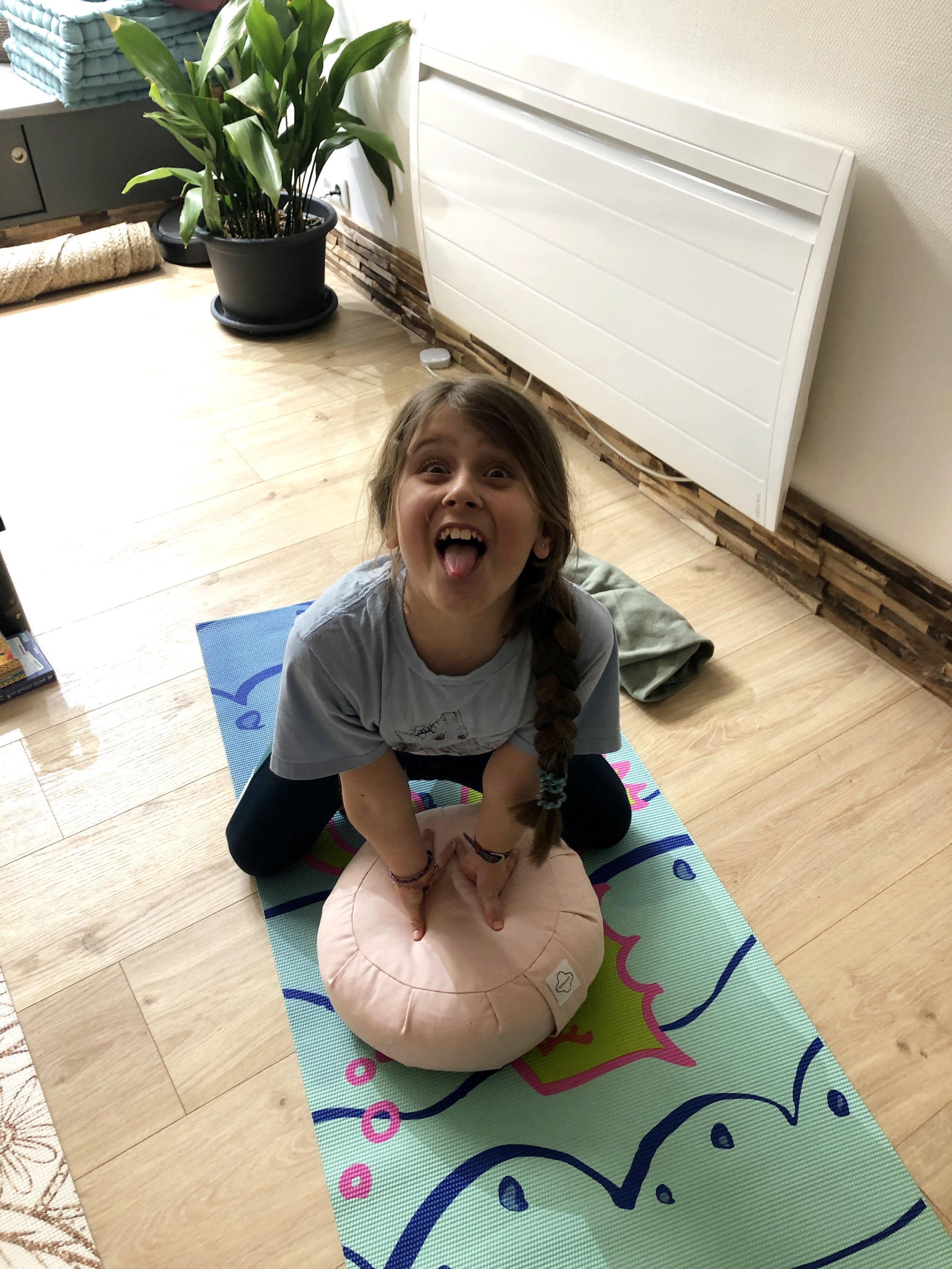Read and learn about the 3 different yoga practices that I teach and what to expect in my sessions:
Trauma-conscious Yoga
Hatha Yoga
Yoga For Children
My wife and I did a year of yoga with Chelsea. It was a novelty for me, and I was rather against it, but in fact it did me a world of good, and I can only recommend Chelsea, especially as we did the lessons in English, which added to the quality of her classes.
-Didier.M (France).
Between school, activities and home, we never have time to rest. When I do yoga with Chelsea, that’s when I can relax. Mom says I’m more composed now. Plus it’s fun, because we play games and it’s relaxing. I also like the English I’m learning in the classes.
-Elyana, 8 years and a half
1. What’s trauma-conscious yoga?
In my opinion, trauma-conscious yoga should be the basis of any yoga class, since it’s about considering the words, actions, and names of poses, and the breathing techniques that could potentially trigger clients in a session. During my yoga training I witnessed a few backfire episodes when clients experienced trauma because the yoga instructor -- for example -- did not explain how a particular breathing technique called Kapalabhati (breath of fire) can resemble a panic attack, or the instructor did not explain other poses that can be potentially very triggering for clients.
Trauma-conscious yoga is preparation information about what each pose and breathing exercise does for the brain and body, and alerts you to ways it may affect you. With this preparation, you become an active participant, and every experience becomes useful information.
Photo: Claire Rounds @claire_rounds_pix
What’s my role as a Trauma-Conscious Yoga Instructor?
As a trauma-conscious yoga instructor, I try to use invitational language, make all my actions predictable (turning off the lights; moving around the room), offer alternative poses as much as possible, remind you to listen to your body, give explanations and use alternative names for potentially triggering poses, and make sure your session is as grounding and relaxing as possible. Yoga class is a place where we should feel safe to relax, let go, and be fully in the present moment.
As a yoga instructor and holistic mental health practitioner, I also make a point to check in with my own biases before working with any individual or group.
Since I have personally experienced post-traumatic stress disorder (PTSD), this yoga resonates deeply with me and I understand the need for people to feel as safe as possible before they can benefit from these teachings.
Do the cultural roots and history of Yoga matter? Yes.
Trauma-conscious Yoga respects and honors the history of yoga as well as its values. Yoga comes from India: it's important to understand, acknowledge, and respect cultural roots that date back to around 3000 years ago. In my sessions, I try to share important points in history, why a certain breath or pose was created, what purpose it serves, and translate the Sanskrit words.
Do I need to be flexible and thin in order to practice yoga? (Biggest myth out there…)
Yoga is not about flexibility or percent body fat. We focus on how body poses feel, rather than how they look.
Photo: Claire Rounds @claire_rounds_pix
“If you have a body then you can practice yoga. It’s just like going to the beach: a body is all you need. ”
What should I expect in a one-on-one trauma-conscious yoga session?
Together, we cover grounding techniques, positive affirmations, asanas (seated poses), pranayamas (breathing exercises), raja yoga (meditation), mudras (hand yoga), chakras (the seven energy centers along our spine), a little history of yoga and some sanskrit, standing poses, and restorative yoga.
One-on-one sessions are adapted to your body's needs. I listen carefully to how you express and carry yourself. We go slowly, since trauma-conscious yoga is about gradually mastering the simple, gentle yoga poses, then moving towards potentially more vulnerable-making and heart-opening poses and more challenging breathing exercises, while fully respecting your mind and body.
We also cover chakras and meditation (raja yoga), considered the purest form of yoga. In the Yoga Sutras of Patanjali asanas (body poses) are only mentioned once, since calming the chitta vrittis (fluctuations of the mind) was the main objective.
A quick note regarding the chakras: when we experience trauma all of our chakras (energy centers along our spine) are thrown out of regulation, along with our nervous system -- so we will go through what chakras are, how to focus on each chakra, and what they mean. In trauma-conscious yoga, we pay attention to changes in sensations.
Please make sure that any known mental health issues have been tended to or are being tended to with a therapist.
Where are the sessions and do I need to buy materials?
I teach online via Zoom as well as in person, and in any yoga studio/space that welcomes me. For in-person/in-studio sessions, we arrange that either you let me know you have your own material, I provide it, or the studio does.
For online sessions via Zoom, you will need to provide your mat and any other materials we arrange that you may need (pillow, blanket, or block).
FYI: you don’t need to buy any expensive materials in order to practice yoga. A tie can serve as a strap, books as blocks, and most mats are affordable.
IMPORTANT: Before we work together, please make sure yoga is appropriate to your fitness level (if in any doubt please see a doctor, especially if you have a history of injury). A waiver, as well as an invoice, will be sent to you via email before our first session together.
As with all of the different disciplines I work in, it’s important to note that yoga is not a replacement for therapy. However, you may contact me to work together on any remaining anxieties you may have. You may also want to try trauma-conscious yoga even if you don’t have experienced trauma -- and you are welcome, of course.
2. What’s Hatha Yoga?
Photo: Claire Rounds @claire_rounds_pix
“There can be no perfection if hatha yoga (the foundation of all yoga) is without raja yoga (meditation) or raja yoga without hatha yoga. The entire world is only a fabrication of thought. Play of mind is only created by thought. By transcending the mind which is composed of constructed thought, definitely peace will be attained.”
Yoga is considered a state of being. The asanas (physical postures) enhance the healthy body in order to have a healthy mind. In the original practices, you move your body in order to meditate better for long hours in a seated position.
The course is at a beginner’s level for adults. In all of my yoga classes, I apply a trauma-conscious lens. Therefore I am careful with my word use and alert to the sensitivity and experiences of the students in the room. In my opinion, yoga is about being gentle with ourselves and others: one of the basic principles of yoga is satya, non-violence. Providing options and giving choices is also at the center of what I do. The goal is for you to do what feels right for you and no one knows what is better than you.
Photo: Claire Rounds @claire_rounds_pix
What to expect in an adult beginner's Hatha Yoga class with me:
You will advance at your own pace.
There is no competition here, not even with yourself.
Yoga will be different every day for you depending on your energy level and state of being.
You will practice prevention (including good alignment and bending the knees).
You will focus on being gentle to your body and mind.
You will focus on creating a harmonious relationship with yourself.
Your goal will be to find inner peace.
I will focus on creating a safe space.
Note: please let me know before the class starts if you have any injuries since I will need to adjust.
As a yoga teacher, I believe that the most important aspects of the class are to transmit elements of meditation (raja yoga), breathing techniques (pranayamas), re-centering, and reconnecting the mind with body. Another very important aspect is working on energy levels through the chakras. Performing a yoga pose perfectly is not the main goal: what’s crucial is for you to feel the benefits of each pose both physically and in your mind.
Photo: Claire Rounds @claire_rounds_pix
“I practice yoga in order to include gentle movement to my day, to see what I am capable of doing physically and mentally, to switch off the mind, to breathe, to be, and to become more creative. Yoga makes me feel like a human being and that there is just the present moment. Most of all, the practice of keeping the mind still is a gift you can use in any situation in your life, especially the most difficult moments. As for your body: you will thank yourself later in life for doing yoga since it keeps your body healthy and young.”
3. What’s Yoga for Children? Why does it matter?
Yoga for the future: Yoga will enable your children to grow consciously, with an awareness of the present moment. It gives them tools to respect themselves and others, to express their emotions, and to express gratitude. Yoga for Children consists of letting children be their truest selves, respecting and strengthening their bodies by practicing yoga poses, respecting others, and having fun.
The children learn breathing exercises, affirmations and chants (mantras), and meditation; they develop the creative side of their brains and their motor skills and come to understand yoga’s values of honesty, gratitude, discipline, non-violence, and paying attention to life’s daily lessons. Breathing exercises and meditation enable children to relax/take time for themselves after school/during the weekend. In terms of breathing exercises, it's different than a session for adults with "real" breathing exercises (pranayamas), for children it's more about observing the breath. Real pranayamas can start to be taught at age 9.
A typical session:
The children and I arrange our mats in a circle, sitting in asana pose while paying attention to our breathing and being aware of the present moment.
Every session begins with the classic ritual of bringing our hands into the Namaste Anjali mudra pose (the welcome/hello yoga sign) and chanting 'om' three times. Tailoring the session to the children's age, we play games using yoga poses, act out a story with yoga poses transmitting the story's values, and end with a relaxation time. Then we say 'Namaste' (goodbye), and roll up our mats to put them away.
In my sessions, yoga is also about learning to work together as a team: yoga is the opposite of competition. Yoga is about accepting each other, learning to accept and understand, and mastering emotions. Yoga builds confidence, a sense of responsibility, and perseverance.
As a teacher, I enable the children to learn to structure activities and I provide tools for a healthier body and mind. I am flexible in my sessions, adapting to the children's energy levels and focus.
I create yoga stories during the sessions because stories are essential: they enable children to create an imaginary world, which activates both the conscious and unconscious mind. I carefully listen to how the children feel emotionally and physically and adapt the story to their needs.
Most important: I make sure the yoga is safe and that the children respect their bodies. I am trained in the anatomy of activities and yoga poses that children can do based on age and physical development.
Occasionally, I insist on silence. Silence can enable children to find balance in body and mind.
FYI: Yoga is a state of mind and body, not a religion.
IMPORTANT: Children must bring a medical certificate that attests that they can do yoga and I will request that parents sign an agreement form before their children can take classes with me.
Where do you teach and do I need to buy materials?
I teach online as well as in-person in schools and any other space that is COVID-safe for children to learn the benefits of yoga.
Mats and any other materials will be provided unless there is discussion in advance.
How do I contact you if I am interested in a session for my child or for my organization/school/work place/event?
You may contact me via e-mail at chelseacoachcarter@gmail.com or call me on WhatsApp at: 06.15.67.08.84












